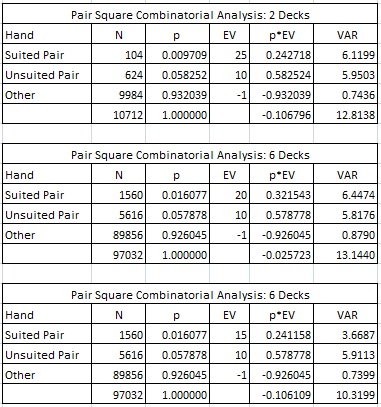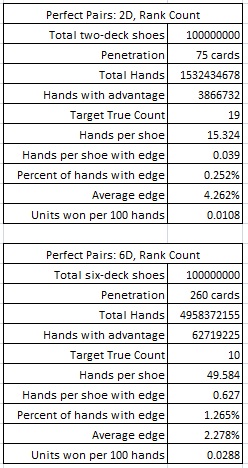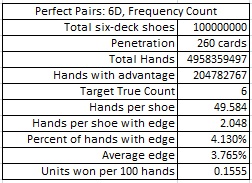Pair Square (PS) is a simple-minded blackjack side bet that pays if the player’s first two cards are a pair. There is a premium payout if the pair is suited. This bet is also known by the name “Bet the Set,” though I have never understood that name, as a “set” usually refers to Three-of-a-Kind in poker. This side bet has been around as long as the crows, but the question of vulnerability to advantage play has rarely been asked. There are no references to PS in Grojean’s “Beyond Counting,” and a Google search also comes up blank. However, a simple thought experiment shows this wager must be vulnerable.
The right way to estimate the maximum vulnerability of PS is to “integrate.” This gives the optimal earnings possible by using computer-perfect play. My approach will be considerably more simple-minded. A few weeks ago I thought of a possible way to beat the bet. I simulated it and got some results. The method worked. Then I thought of a possibly stronger method. That worked too and it was better. I make no apologies for my lack of use of analytical power tools for this bet. Sometimes the bet just doesn’t deserve it.
There are different pay tables for the two-deck and six-deck versions. Reducing the number of decks normally increases the vulnerability of a bet to a card counting methodology. However, in the case of PS, the increase in house edge from the six-deck version 20/10 pay table (2.5723%) to the two-deck version 25/10 pay table (10.6796%) is enough to quash any such potential advantage. But the 20/10 pay table is very rare. Much more common for the six-deck game is the 15/10 pay table (10.3199%). The upshot is that the AP must scout for the 20/10 pay table if he has any chance against this bet.
Here is the combinatorial analysis:

My first idea was to use the “Rank count.” To do this, I grouped the cards into two subsets of six cards each. One group consisted of the low cards {2, 3, 4, 5, 6, 7}, which are given the tag +1. The other group consisted of the high cards {9, T, J, Q, K, A}, which are given the tag -1. If the true count is sufficiently positive, then a pair of high cards is more likely. If the true count is sufficiently negative, then a pair of low cards is more likely. For this reason, the “target true count” refers to a value that indicates both a positive and a negative target.
I simulated one hundred million (100,000,000) shoes using this count in both the two-deck and six-deck game. In the two-deck version, the cut-card was placed at 75 cards (29 from the end). In the six-deck version, the cut-card was placed at 260 cards (52 from the end). The following tables summarize the results from these simulations:

In the six-deck (20/10) version, an AP using the Rank count should make the wager whenever the count is either 10 or higher or -10 or lower. Then the AP will make a PS wager on about 1.27% of his hands, and when he does make the wager, his average edge will be about 2.28%. An AP who finds a game that allows a maximum wager of $100 on PS and is able to play heads-up, getting 200 rounds per hour, will earn about $5.76 per hour playing against PS. In the double-deck version, an AP will earn about $2.16 per hour in a heads-up game getting 200 rounds per hour. None of this is very impressive.
In search of a larger advantage, I created an extreme version of this count I call the “Frequency” count. Rather than grouping the cards into two sets, I computed a true count using a metric similar to that used for the 21+3 bet. Namely, keep track of the exact number of cards remaining from the most played rank and least played rank. Subtract the min from the max of these two values to get a “running count.” Then convert that running count to a true count. If the true count is sufficiently large then the AP will have the edge.
For example, mid-way through the shoe, if the distribution of ranks is (11, 10, 9, 8, 7, 6, 12, 13, 14, 15, 16, 17, 18), then the max is 18, the min is 6, the running count is max - min = 18-6 = 12, and the true count is 12/3 = 4.
This method is not human-feasible for blackjack (unless the human starts the shoe with 13 stacks of 24 chips in front of him, has very fast hands, and surveillance and the pit are busy eating doughnuts), but it is still worth checking its performance.
The following table summarizes the results from a simulation of one hundred million (100,000,000) six-deck shoes using the Frequency count:

In the six-deck (20/10) version, an AP using the Frequency count should make the wager whenever the true count is 6 or higher. Then the AP will make a PS wager on about 4.13% of his hands, and when he does make the wager, his average edge will be about 3.77%. An AP who finds a game that allows a maximum wager of $100 on PS and is able to play heads-up, getting 200 rounds per hour, will earn about $31.10 per hour playing against PS. Not too bad, as long as the AP remembers to bring some doughnuts.
Unfortunately for the AP, the six-deck pay table with a payout of 20-to-1 for a suited pair is hard to find. At a house edge of only 2.57%, it doesn’t pay the rent. More common will be a 15-to-1 payout for a suited pair (house edge = 10.6109%).
Here are my suggestions for protecting the Pair Square bet:
- Don’t allow doughnuts in the pit or in surveillance.


